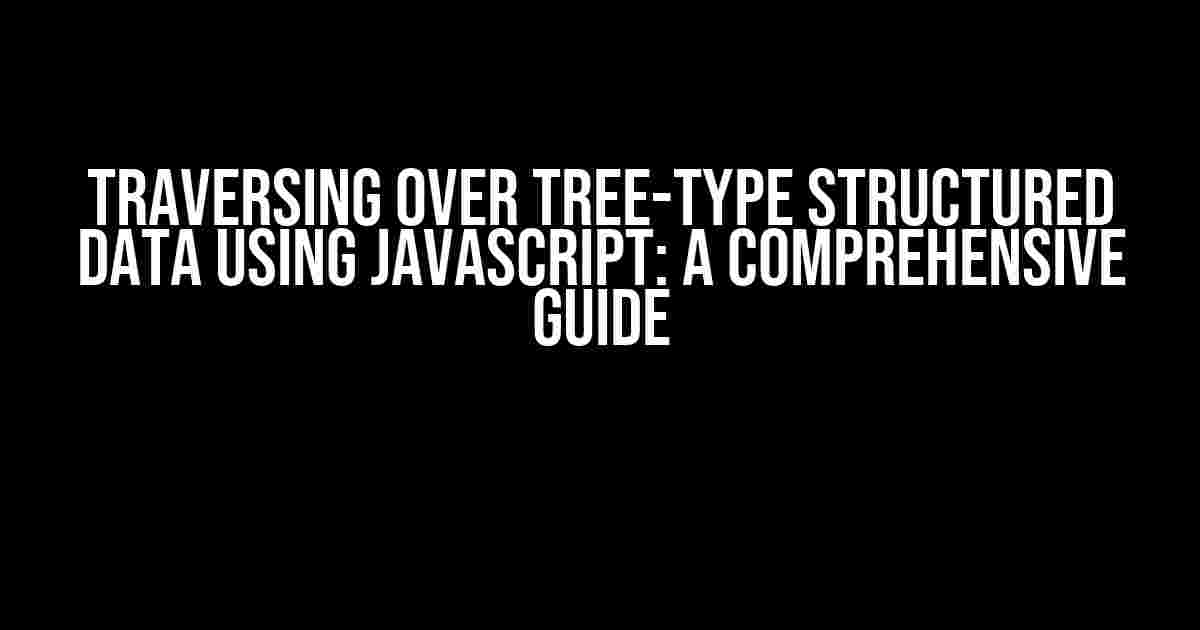Imagine having a hierarchical data structure that resembles a tree, where each node has a parent and children nodes. Sounds familiar? You’ve probably encountered such data structures in the form of file systems, organizational charts, or even nested HTML elements. But have you ever wondered how to traverse over such tree-type structured data using JavaScript? Look no further, as we’ll embark on a journey to explore the world of tree traversal and learn how to efficiently navigate through these complex data structures.
What is Tree Traversal?
Tree traversal refers to the process of visiting each node in a tree data structure in a specific order. It’s like walking through a forest, where you need to navigate through the trees to reach the desired destination. In the context of JavaScript, tree traversal allows you to access and manipulate the nodes in a tree-type structured data, which is essential for various applications, such as:
- DOM manipulation
- Data processing and analysis
- Algorithm implementation
- GUI component rendering
Types of Tree Traversal
There are three primary types of tree traversal: Breadth-First Traversal (BFS), Depth-First Traversal (DFS), and In-Order Traversal. Each has its unique characteristics and use cases.
| Type | Description | Example |
|---|---|---|
| Breadth-First Traversal (BFS) | Visits all nodes at a given level before moving to the next level | Walking through a forest, exploring all trees at a certain distance before moving further |
| Depth-First Traversal (DFS) | Visits as far as possible along each branch before backtracking | Following a single path in the forest, exploring as deeply as possible before returning |
| In-Order Traversal | Visits the left subtree, then the current node, and finally the right subtree | Exploring a tree in a specific order, such as alphabetically or numerically |
Implementing Tree Traversal in JavaScript
Now that we’ve covered the basics of tree traversal, let’s dive into implementing it in JavaScript. We’ll create a sample tree data structure and explore each traversal type using practical examples.
// Sample tree data structure
const tree = {
id: 1,
name: 'Root',
children: [
{
id: 2,
name: 'Child 1',
children: [
{
id: 4,
name: 'Grandchild 1'
},
{
id: 5,
name: 'Grandchild 2'
}
]
},
{
id: 3,
name: 'Child 2',
children: [
{
id: 6,
name: 'Grandchild 3'
}
]
}
]
};
Breadth-First Traversal (BFS) Implementation
BFS is an excellent choice when you need to traverse the tree level by level. We’ll use a queue data structure to implement BFS.
function bfsTraverse(tree) {
const queue = [tree];
while (queue.length > 0) {
const currentNode = queue.shift();
console.log(currentNode.name);
if (currentNode.children) {
queue.push(...currentNode.children);
}
}
}
bfsTraverse(tree);
// Output:
// Root
// Child 1
// Child 2
// Grandchild 1
// Grandchild 2
// Grandchild 3
Depth-First Traversal (DFS) Implementation
DFS is suitable when you need to explore as far as possible along each branch before backtracking. We’ll use a recursive function to implement DFS.
function dfsTraverse(node) {
console.log(node.name);
if (node.children) {
node.children.forEach(dfsTraverse);
}
}
dfsTraverse(tree);
// Output:
// Root
// Child 1
// Grandchild 1
// Grandchild 2
// Child 2
// Grandchild 3
In-Order Traversal Implementation
In-order traversal is useful when you need to traverse the tree in a specific order, such as alphabetically or numerically. We’ll use a recursive function to implement in-order traversal.
function inOrderTraverse(node) {
if (node.children && node.children.length > 0) {
inOrderTraverse(node.children[0]);
}
console.log(node.name);
if (node.children && node.children.length > 1) {
inOrderTraverse(node.children[1]);
}
}
inOrderTraverse(tree);
// Output:
// Grandchild 1
// Child 1
// Grandchild 2
// Child 2
// Grandchild 3
// Root
Best Practices and Performance Considerations
When working with tree traversal, keep the following best practices and performance considerations in mind:
- Use a suitable traversal type based on your application’s requirements
- Optimize your traversal function for performance, especially with large datasets
- Consider using a iterative approach instead of recursive functions to avoid stack overflow issues
- Use caching or memoization to store intermediate results and reduce computation time
- Test your traversal function with various input datasets to ensure correctness and edge cases
Real-World Applications of Tree Traversal
Tree traversal has numerous real-world applications in various domains, including:
- DOM manipulation and event handling in web development
- Data processing and analysis in machine learning and data science
- Folder and file system navigation in operating systems
- Database query optimization and indexing
- Compilers and interpreters for programming languages
In conclusion, traversing over tree-type structured data using JavaScript is a fundamental concept in computer science. By understanding the different types of tree traversal and implementing them in JavaScript, you’ll be able to tackle complex data structures with ease and efficiently navigate through the hierarchical data.
Remember to practice and experiment with different traversal types and scenarios to solidify your understanding of this crucial concept.
Happy coding, and may the trees be ever in your favor!
Here are the 5 questions and answers about traversing over tree type structured data using JavaScript:
Frequently Asked Questions
Get ready to dive into the world of tree-type structured data and JavaScript!
What is tree-type structured data, and why do I need to traverse it in JavaScript?
Tree-type structured data is a hierarchical data structure where each node has a value and zero or more child nodes. Think of it like a family tree or a file system! You need to traverse this data in JavaScript to access, manipulate, or extract specific information from the nodes. Imagine you’re searching for a specific file in a folder – you need to navigate through the folders to find it!
What is the difference between Breadth-First Traversal (BFS) and Depth-First Traversal (DFS) in JavaScript?
BFS explores all the nodes at the current level before moving on to the next level, like drawing a horizontal line across the tree. DFS, on the other hand, explores as far as possible along each branch before backtracking, like drawing a vertical line down the tree. Think of BFS as a level-by-level search and DFS as a branch-by-branch search!
How do I implement a recursive DFS traversal in JavaScript?
You can implement a recursive DFS traversal by defining a function that takes a node as an argument, performs some operation on that node, and then recursively calls itself on each of the node’s children. Think of it like a function calling itself until it reaches the leaf nodes!
What is the advantage of using a stack-based iteration for traversing tree-type structured data in JavaScript?
Using a stack-based iteration allows you to avoid the maximum call stack size limit imposed by JavaScript, making it suitable for large datasets. It’s also more memory-efficient and easier to implement than recursive functions. Think of it like using a stack of plates – you can add and remove plates without worrying about the stack size!
How do I optimize the performance of traversing tree-type structured data in JavaScript?
To optimize performance, use caching to store the results of expensive operations, and consider using a just-in-time (JIT) compiler or a memoization technique to reduce the number of function calls. You can also use Web Workers to offload the computation to a separate thread, freeing up the main thread for other tasks. Think of it like optimizing a recipe – you can use shortcuts and tricks to make it faster and more efficient!


